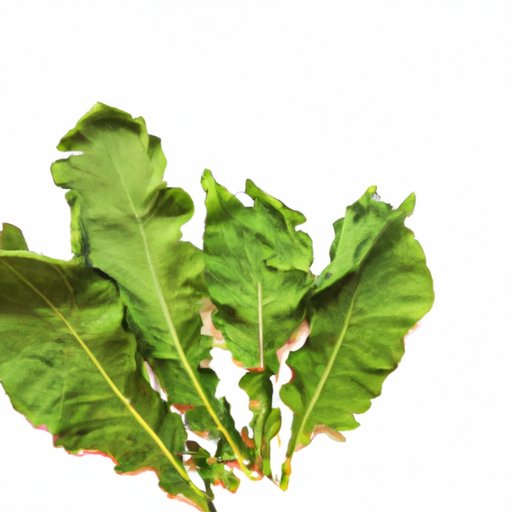
Introduction
If you’re like most people, you probably only eat the crunchy red or white bulbs of radishes, tossing the leafy green tops into the compost or trash without a second thought. But did you know that those greens are not only edible but also packed with powerful nutrients and flavors?
In this article, we’ll explore the benefits and risks of eating radish leaves, give you some creative recipe ideas, and highlight the cultural significance of this often-overlooked ingredient.
Benefits and Risks
Radish leaves are highly nutritious, containing a wide range of vitamins, minerals, and antioxidants. They’re particularly rich in vitamins C and K, as well as calcium, iron, folate, and potassium. Eating them can help strengthen your immune system, support healthy bones and blood clotting, and even reduce inflammation and cancer risk.
However, there are also some potential risks associated with consuming radish leaves. These greens contain high levels of oxalic acid, which can interfere with the absorption of calcium and lead to kidney stones in some people. In addition, they may be contaminated with pesticides or other chemicals, particularly if they’re not washed thoroughly.
To minimize these risks, it’s important to wash your radish leaves thoroughly and cook them before eating. Boiling or blanching them can help reduce their oxalic acid content, as can pairing them with calcium-rich foods like dairy, nuts, or leafy greens.
Finally, it’s worth debunking a common myth surrounding radish leaves: that they’re poisonous or toxic. In fact, while they may be bitter or spicy in taste, they’re perfectly safe and healthy to eat in moderation.
Recipe Ideas
So, how can you incorporate these peppery greens into your cooking? Here are a few ideas to get you started:
1. Radish Leaf Soup
Cut off the stems and chop up a few handfuls of radish leaves. Saute some garlic and onions in olive oil, then add the leaves and a bit of vegetable broth. Simmer until the leaves are tender, then puree the soup with an immersion blender. Add salt, pepper, and cream to taste.
2. Radish Leaf Salad
Mix together chopped radish leaves, diced radishes, sliced cucumbers, and crumbled feta cheese. Drizzle with olive oil and lemon juice, and season with salt, pepper, and a pinch of sugar.
3. Radish Leaf Stir-Fry
Stir-fry sliced mushrooms and carrots in a hot pan until tender. Add in chopped radish leaves and a dash of soy sauce, and stir until the leaves are wilted. Serve over rice or noodles.
4. Radish Leaf Smoothie
Blend together a handful of radish leaves, a banana, a scoop of Greek yogurt, and some almond milk until smooth. Add honey or maple syrup to sweeten, if desired.
Alternatively, you can use radish leaves as a garnish for other dishes, or incorporate them into omelets, sandwiches, or pasta sauces for an extra boost of flavor and nutrition.
Sustainability and Waste Reduction
Another reason to eat radish leaves? They’re a great way to reduce food waste and promote more sustainable eating habits. By using the entire radish plant, from the roots to the leaves, you can cut down on the amount of food that goes to waste in your kitchen.
In addition, choosing to eat more plant-based meals, such as those featuring radish leaves, can help reduce the environmental impact of your diet. Plants generally require less water, land, and energy to produce than animal products, making them a more eco-friendly choice.
To incorporate radish leaves into your diet more easily, consider growing your own radishes at home. This way, you can ensure that the leaves are free of pesticides or other contaminants, and you can use them fresh from the garden whenever you want.
Cultural Significance
Radish leaves are not only nutritious and sustainable, but also culturally significant in many parts of the world. In Japan, for example, the leaves are often used in soups, dressings, or side dishes, and are said to represent good luck and prosperity.
In Mexican cuisine, radish leaves are used to make a traditional salsa verde, adding a pungent, herbaceous flavor to tacos, burritos, or quesadillas. In India, they’re often used in curries or chutneys, and are believed to aid in digestion and prevent constipation.
By learning more about these cultural traditions, you can deepen your appreciation for radish leaves and their unique flavors and uses. And by sharing these recipes and stories with others, you can help preserve and promote these important cultural practices.
Health Conditions and Special Diets
Finally, if you have specific health conditions or dietary restrictions, you may be wondering whether or not radish leaves are safe for you to eat.
For most people, radish leaves are a healthy and nutritious addition to their diets. However, if you have a history of kidney stones, it’s recommended that you limit your intake of high-oxalate foods like radish leaves.
If you follow a vegan or gluten-free diet, or if you’re looking for a low-calorie, low-fat ingredient, radish leaves can be a great option. They can add flavor and nutrition to salads, sandwiches, and other dishes without adding a lot of extra calories or fats.
Finally, if you have any concerns or questions about incorporating radish leaves into your diet, it’s always a good idea to consult with a healthcare professional or a registered dietitian.
Conclusion
Eating radish leaves may not be the first thing that comes to mind when you think of healthy, sustainable eating. But by exploring the benefits and risks of this versatile ingredient, discovering creative recipe ideas, and learning about its cultural significance and place in different diets, you can discover a whole new world of flavors and nutrition.
So, the next time you buy a bunch of radishes, don’t toss those leaves aside. Instead, give them a try and see how they can enhance your cooking and your health.




